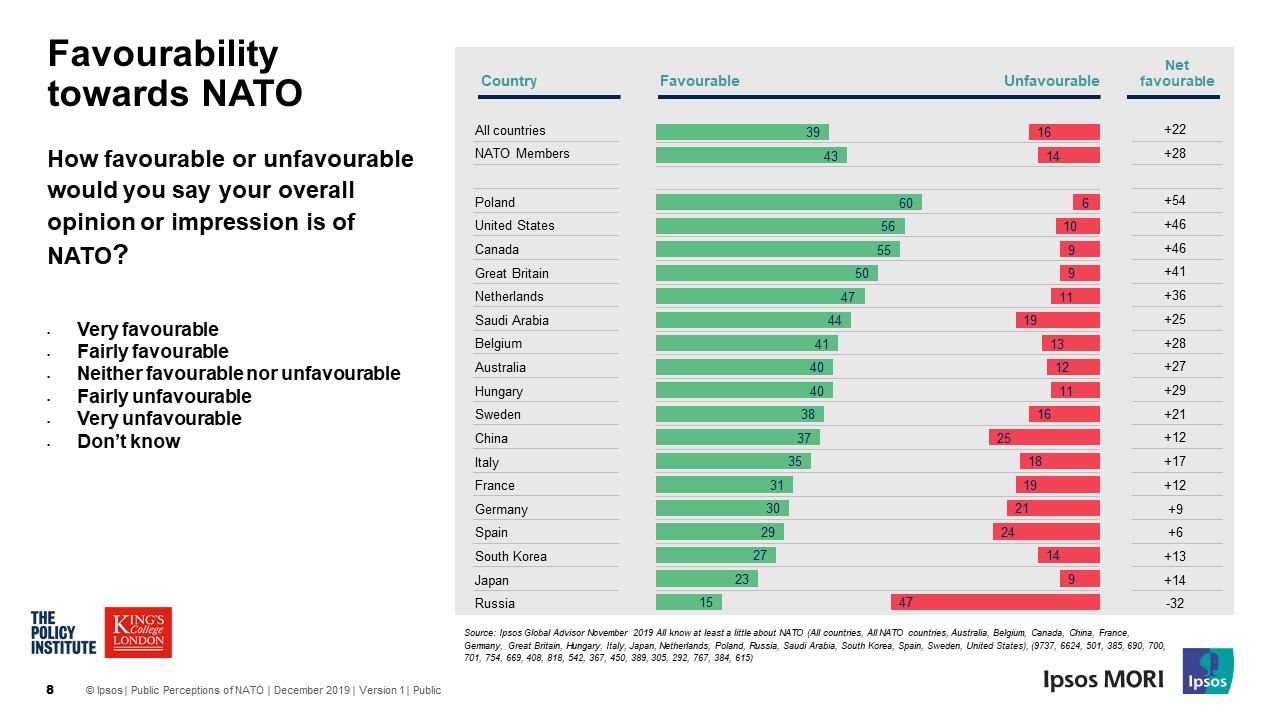NATO is seen as a force for good, but support is low in key member states
While the public in NATO member states tend to see the Alliance as a force for good, favourability is low in a number of key member states, according to a new survey ahead of the NATO Leaders Meeting on 4 December.
The research, by the Policy Institute at King’s College London and Ipsos, finds that across 11 NATO countries surveyed1, 43% of the public who know at least a little about the Alliance have a favourable view of it, while 14% have an unfavourable view and 43% have a neutral view.
Favourability towards NATO is highest in Poland (60%), the US (56%), Canada (55%) and Britain (50%), but low in some key member states:
- Germany: 30%
- France: 31%
- Italy: 35%
- Spain 29%
But in the NATO countries polled, more people agree (40%) than disagree (14%) that the organisation is a force for good in the world, while 26% have a neutral view.

There are significant misunderstandings about how NATO is funded and how it functions
Across the 11 NATO member countries surveyed, the public hugely underestimate the United States’ financial contribution to the security organisation. The average guess is that 39% of NATO funding comes from the US when the actual figure is 69%.2
The polling also reveals other misperceptions about how the organisation is funded and how much nations spend on defence:
- While people in the member states surveyed underestimate the financial contribution of the US to NATO, they overestimate their own nation’s contribution. People in Britain are most accurate, with an average guess of 14% funding – which is still more than double the actual figure of 6.23%. People in France and Germany guess their country’s contribution is three times the reality of around 5%. The least accurate guess comes from Hungary, where people think their country’s contribution is 50 times higher than the actual share of 0.18%.
- In every NATO member state surveyed, the public are more likely than not to think their country meets the recommended spending target of at least 2% of GDP on defence – even though only three of the 11 member states surveyed actually do.3
- However, across the 11 NATO countries polled, more people disagree than agree that NATO should not protect member countries that spend less than 2% of GDP on defence (35% vs 14%).
- 40% of Americans disagree that NATO is a waste of money, compared with 14% who agree. While in Britain, 44% disagree and just 9% agree.
NATO’s goals
Of a wider group of countries surveyed, people in Britain are least likely (11%) to believe that one of NATO’s purposes is to harm Russian interests, while 56% of Russians believe this is the case – the highest in the survey.
People in Russia (72%) and China (68%) are most likely to think NATO’s purpose is to protect US interests.
People in China (74%), the Netherlands (64%), South Korea (61%), Russia (60%) and Sweden (60%) are most likely to say that NATO’s purpose is to protect Western interests.
Dr Benedict Wilkinson, Associate Director at the Policy Institute, King’s College London, said:
This polling suggests that President Trump’s rhetoric is beginning to bite. Attitudes towards NATO, even in key member states, are less positive than they could be, and may even be in decline. This, coupled with serious public misunderstandings about levels of military expenditure of NATO states, poses real problems for the organisation. It will have to find new ways of persuading the public of its value in the 21st century, while simultaneously encouraging member states to invest more to meet the target of spending 2% of GDP on military equipment.
Mark McGeoghegan, Research Manager at Ipsos, said:
Though the public in NATO member states tend to see the Alliance as a force for good in the world, there are overall low levels of favourability in key European members and a clear lack of understanding of how NATO functions. The support of the public is core to strengthening NATO’s capacity to deal with an increasingly complex international system and face down emerging security challenges – as NATO heads of state gather in London, they face a challenge in building that public support in the coming years.



